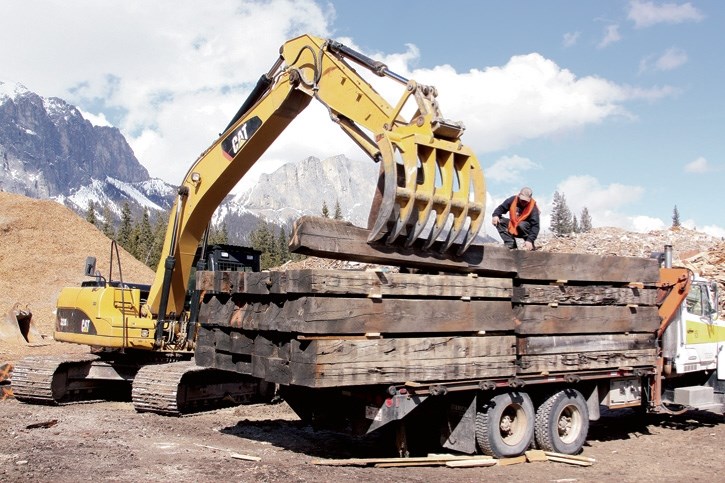The old axiom “one man’s trash is another’s treasure” was in evidence last week at the Francis Cooke landfill site east of Exshaw.
In this case, though, the trash in question is not household items like dishes, old auto parts, kids’ toys or furniture; rather, the trash in question is Douglas fir timbers that had been removed from Canmore’s old engine bridge when it was refurbished in 2016.
The timbers had taken up space at the landfill for about a year and their future was likely to go the route of most other construction wood waste at the landfill – into woodchips for feedlot bedding.
Andrew Calder, CAO of the Bow Valley Waste Management Commission and landfill site manager, though, had other ideas.
“I really thought there had to be some value in the things, and that they could be repurposed,” he said. “If we could find someone who wanted them, it would be a win-win. It would meet the principles of management and the three Rs of recycling and reduce the chipped material we have here.”
With recycling and repurposing in mind, Calder contacted Michael Gerrand of Pincher Creek’s Salvage Solutions Ltd., a family run operation that specializes in antique building audits, restoration and refurbishment and deconstruction and recovery of old buildings.
Aiming to “reclaim, recover, repurpose,” Salvage Solutions uses reclaimed lumber and timbers and repurposes it into décor ranging from dining tables and countertops to fireplace mantels and rustic wall paneling.
The timbers, of about 10 x 16-inch and three metres in length, were once the foundation into which rails were attached with spikes on the bridge.
“They were old growth Douglas fir,” said Calder, “and it seemed there should be a better use for them than animal bedding. I’m really looking forward to what they (Salvage Solutions) produce with them.”
In all, Calder and Gerrand swung a deal for about 80 of the timbers, which landfill staff loaded and hauled to Pincher Creek, and which should see a new table for a new office returned once crafted.
“It would have been about 10 tons of timbers,” said Calder, “but this will keep them out of the landfill site and every little bit helps. Every ton of material has to be handled and we go through about 1,000 tons of construction waste a year (pallets, construction off cuts, etc.).
“By turning them into furniture, people will get to enjoy them, not just cattle. And reusing material like this is getting quite popular (ie. the TV show Barnwood Builders).
Salvage Solutions’ focus, said Gerrand, is on recycling of materials, so what isn’t salvaged from the former engine bridge timbers will go toward heating his home with a wood stove.
With six-inch rail spikes driven into the timbers, Gerrand said, water damage occurred where it found its way into the wood. But, after damaged sections are removed, the timbers will be milled into dimensional lumber which can be turned into décor creations for the home.
“And being that these timbers were over the river, they weren’t treated, so there’s no creosote or anything to make them unusable. That’s one of the advantages of this type of deck timber.
“I think what the guys are doing here (landfill) is awesome. There is value in these timbers because they can be made into harvest tables or countertops of about three inches thickness. We should be able to get one table out of about three timbers.
“Who knows, maybe someone who got married near the engine bridge would want a table from this as a memento? It would be a table with a story and ‘Wood with a story’ is our motto.”
Salvage Solutions opened in 2012, with sales across Western Canada, and Canmore is now one of the company’s largest growing markets for homeowners looking for rustic, well built, high-end furniture.
Gerrand said the timbers will be dried for several months, to get them to an ideal eight per cent moisture content, before milling.
“The nice thing about timbers like this,” he said, “is they’re so stable. Every bit of movement that’s going to happen in the wood has already happened over the years.”
Currently, Gerrand is doing some online research to try and figure out the age of the timbers. He thinks the fact the timbers were cut with a circular saw, and that the railway spikes are six-inch may offer some clues.
The Francis Cooke landfill itself is in the midst of an overhaul, after a fire destroyed the former office, a new one is nearing completion for the beginning of April.
The new building will feature a solar installation and a biomass burner/boiler system with in-floor heating which will also use construction waste for fuel.
The new office will also be more secure, with cameras and alarms installed, and more energy efficient with greater insulation.
“It should all help us reduce energy costs and greenhouse emissions,” said Calder.




